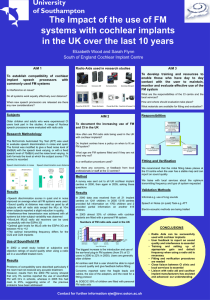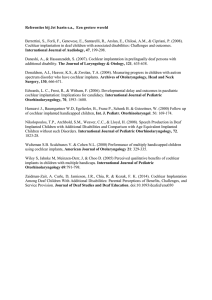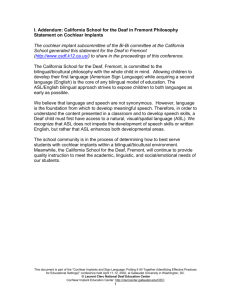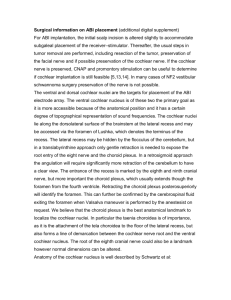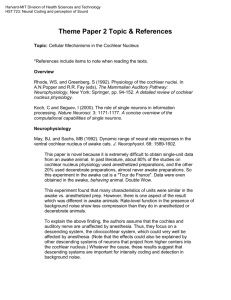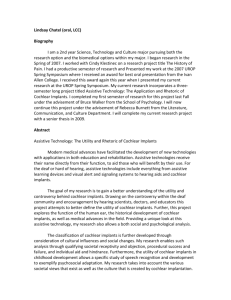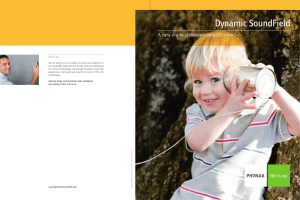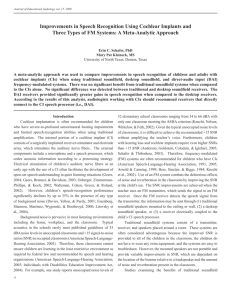Optimal FM Arrangements for Cochlear Implant Users
advertisement
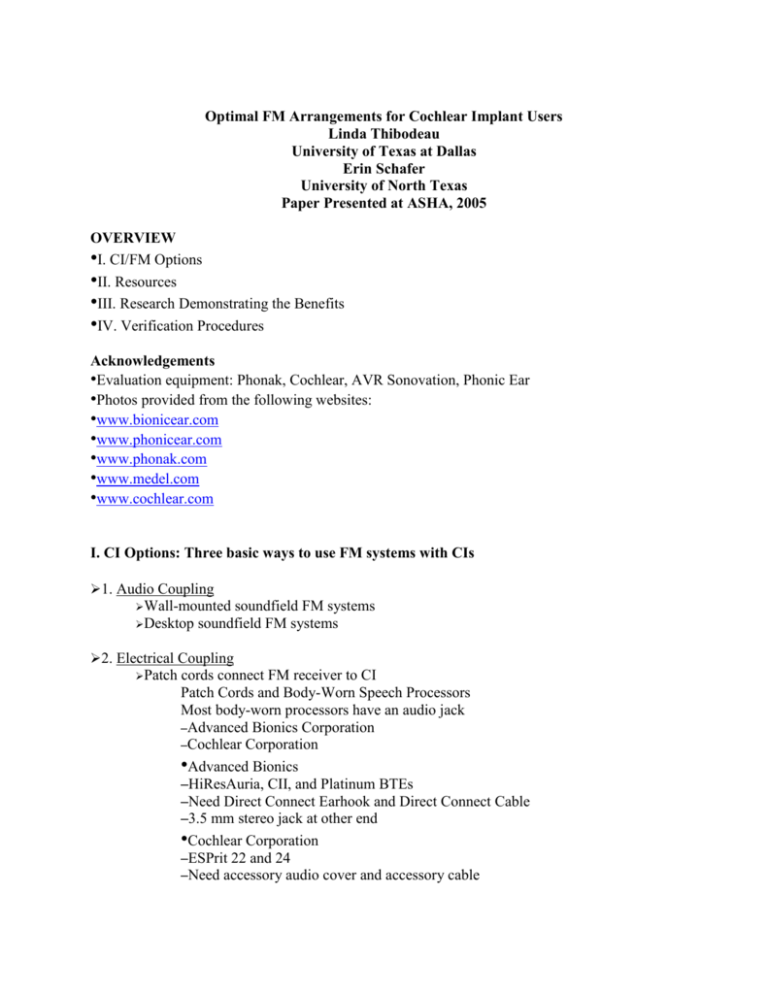
Optimal FM Arrangements for Cochlear Implant Users Linda Thibodeau University of Texas at Dallas Erin Schafer University of North Texas Paper Presented at ASHA, 2005 OVERVIEW •I. CI/FM Options •II. Resources •III. Research Demonstrating the Benefits •IV. Verification Procedures Acknowledgements •Evaluation equipment: Phonak, Cochlear, AVR Sonovation, Phonic Ear •Photos provided from the following websites: •www.bionicear.com •www.phonicear.com •www.phonak.com •www.medel.com •www.cochlear.com I. CI Options: Three basic ways to use FM systems with CIs 1. Audio Coupling Wall-mounted soundfield FM systems Desktop soundfield FM systems 2. Electrical Coupling Patch cords connect FM receiver to CI Patch Cords and Body-Worn Speech Processors Most body-worn processors have an audio jack –Advanced Bionics Corporation –Cochlear Corporation •Advanced Bionics –HiResAuria, CII, and Platinum BTEs –Need Direct Connect Earhook and Direct Connect Cable –3.5 mm stereo jack at other end •Cochlear Corporation –ESPrit 22 and 24 –Need accessory audio cover and accessory cable •MED-EL –TEMPO or TEMPO+ –Need specialized cord for specific receivers Cable-connect receiver Plugs into speech processor with a cable provided by the manufacturer of the receiver MLCI-Available for all processors Direct plug-in of FM receiver CI can be used with any processor May need processor patch cord Logicom Programmability of FM Advantage Can adjust FM advantage of Phonak MLxS using programming software 3. T-Coil Coupling Processor has t-coil to receive electromagnetic signal from the body-worn FM system with neckloop T-coil available on some speech processors may be used with neckloop for body-worn FM receivers No research to support this arrangement Disadvantages: –Signal may vary with orientation of t-coil –May reduce low-frequency input to listener –T-coils add noise II. Resources www.phonak.com/professional/ Resources: Phonak Compatibility Guide Resources: Phonak eSchool Desk Phonak FM Fitting Guidelines for Cochlear Implants (will be on eSchool Desk soon) www.bionicear.com Resources: FM and T-Coil: Advanced Bionics Corporation (User Support: Processor User Guides) Resources: Audiology Online Course www.audiologyonline.com –Interfacing the Auria iConnect with the Phonak MLxS FM Receiver –Go to: Start e-learning now –Recorded courses –Select Advanced Bionics as manufacturer –Course #4263 www.medel.com Resources: MED-EL FM Guide •www.utdallas.edu/~thib/ •EARRING CD ROM •www.utdallas.edu/loizou/cimplants/ •Cochlear Implant information and Demos III. Research Demonstrating the Benefits of FM Systems used with Cochlear Implants 1. Benefit of Soundfield FM Systems •Crandell, Holmes, Flexer, & Payne, 1998 –Word recognition –Conditions: for 8 children and 10 adults with CIs CI alone Quiet 72% Sound Field FM 70% Noise 70% 69% –Results for adults and children similar –Averaged Results: No significant benefit of SoundField Systems •Iglehart, 2004 –Word recognition in noise for 14 children with CIs –Listening conditions varied by reverberation (poor and –Conditions: Poor Ideal CI Alone 13% SD=9 41% SD=13 Wall FM System 25% SD=11 50% SD=16 ideal) Desktop FM System 38% SD=15 48% SD=17 -Performance with FM systems significantly better than CI alone 2. Comparisons of Systems •Schafer and Thibodeau, 2003 –Word recognition with 8 adults with CIs –Conditions: • Quiet Noise CI Alone 83% SD=13 36% SD=27 Phonic Ear Toteable DNT 45% SD=26 Phonic Ear Easy Listener DNT 71% SD=19 AVR Sonovation Logicom CI DNT 66% SD=66 -No difference between desktop and CI alone -Significantly better than CI alone with electrically coupled Phonic Ear Easy Listener or Sonovation Logicom •Anderson et al, 2005 -Word recognition with 6 children with CIs -Conditions: –CI Alone 78% (SD=17) –Infrared SoundField 65% (SD=19) –Desktop SoundField 87% (SD=14) –Electrically-Coupled 91% (SD=9) No significant difference across FM systems; possibly related to ceiling effects; many scored 90% or higher without FM system so there was no room for improvement •Schafer & Thibodeau, 2004 –10 children with CIs -Comparison of FM Arrangements: Quiet CI Alone Noise CI Alone 80% 45% Phonic Ear Toteable 70% Phonic Ear Easy Listener 75% AVR Sonovation Logicom CI Phonak ML CI 67% 72% -Significant decline in performance for Noise CI alone vs Quiet CI Alone -Significant benefit with FM Systems -No significant difference across FM Systems •Schafer, 2005 -22 children with CIs -12 children with bilateral implants -10 children with bimodal arrangements (CI and HA on non-implant ear) -Conditions: No FM System Conditions Bilateral Group Bimodal Group FM System Conditions Bilateral Group Bimodal Group CI Alone 1.9 dB 1.2 dB CI/FM + no 2nd -12.5 -10.8 CI+ 2nd -0.4 dB 1.5 dB CI/FM+ 2nd -12.3 -12.5 CI + 2nd/FM -3.0 -0.9 FM input to first or both sides allowed for best speech recognition in noise performance! Summary of All Research: •In NOISE, we can see benefit of desktop and electrically-connected FM systems •NO peer-reviewed study to suggest connecting FM causes poor signal, interference, or intermittency •Mounting evidence to support the use of FM with CIs •So we no longer need to ask the question, does FM help with CI? •Now questions focused on what is the best FM arrangement (bilateral, bimodal)? CI/FM+ 2nd/FM -15.0 -14.1 IV. Verification Procedures for the CI+FM Interface Informal Testing and Behavioral Testing 1) Informal Testing •Can be performed by the classroom teacher •Quick and easy way to determine that CI and FM are functioning •3 Types: 1. Using a speaker Speaker for Cable-Connect and Direct Connect Receivers •Plug the FM receiver into an amplifier speaker: Radio Shack Mini Amplifier Speaker (Cat. No. 277-1008C) •Speak into the transmitter microphone •Listen to the output through the amplifier speaker 2. Using monitor earphones •Can hear output from CI mic. before it is processed and sent to the electrode array •Can hear output for input to CI and FM simultaneously •Available for Nucleus Processors: 1. ESPrit 3G BTE 2. SPrint Body-Worn 3. Freedom 3. Performing a listening Check – subjective response required from child KEY TO LISTENING CHECKS: •Must give input to both microphones separately •Have the child repeat or act out what you say: 1. Ling – ah, oo, ee, sh, ss, mm 2. Numbers – one, two, three 3. Count syllables – ba, ba, ba 4. Long or short – baaaaa, ba ba ba 5. Simple commands – Hide your face 6. Speech awareness with play – rings, blocks, etc. • 2. Behavioral Testing • Behavioral Testing in the Booth - The ASHA procedure can be used for behavioral testing with FM systems - Speech recognition is the most effective way to measure behavioral benefit with an FM system Testing Equipment for Speech Recognition: - Soundbooth with soundfield speaker and seating at a zero degrees azimuth - Audiometer that allows for live voice speech recognition (SR) testing - Appropriate SR material with multiple lists - Measure speech recognition in noise with the CI alone at a +5 signal-tonoise ratio - If time permits, measure speech recognition in quiet with the CI alone and CI+FM Results Using ASHA Procedure: - Summary of Study - Thibodeau, Schafer, Overson, Whalen, Sullivan (2005) - The average improvement when adding the FM system in noise was 30% •CI alone 45.50 % •CI+FM 75.25 % - The difference between CI alone and CI+FM in Quiet was minimal. •CI alone 76% •CI+FM 75% Current Tests for Children - Bamford-Kowal-Bench Speech in Noise (BKB-SIN) test - Hearing in Noise Test for Children (HINT-C) 1. Fixed signal levels and % correct scoring 2. Adaptive signal levels, threshold - Word Intelligibility by Picture Identification –Revised (WIPI) - Pediatric Speech Intelligibility (PSI) Limitations of Current Speech Recognition Tests: - Vocabulary level - Testing in quiet - Percent-correct scoring Possible Solutions: - Use low-level vocabulary or screen child before testing - Test in noise - Threshold testing NEW TEST UNDER DEVELOPMENT: Children’s Hearing in Noise Test (CHIN) •10 phrases were randomized into 7 different lists •Each list has 28 phrases recorded by female •One condition takes 4 minutes •Children asked to act out phrases with a doll and objects - Sample Scoring Form for CHIN-Descending SNR on the left side, Ascending SNR on the right side, Average SNR at break from correct to incorrect response to get overall SNR SUMMARY The Optimal FM Systems to use with Cochlear Implants are: •Electrically-coupled using the correct patch cord or cable or direct plug-in •Set appropriately to give –Both FM transmitter and CI microphone signals –Improved speech recognition in noise relative to Cochlear Implant alone as supported by: •Research •Informal Testing •Behavioral Testing SUMMARY-Behavioral Testing •Recall that if using percent correct scores: -Large differences are needed to be significantly different-Approx. 30% improvement with CI/FM -Avoid ceiling effects-Noise must be intense enough to reduce CI alone performance •If Child is unable to perform speech recognition task - Test equipment with Adults CI users first if possible - Verify using same techniques that you would use to verify the child’s CI is functioning SUMMARY •Given the risks, costs, and commitment associated with obtaining a Cochlear Implant… •It only makes sense that one would do everything possible to provide the most optimal signal…. •THEREFORE------------- Consider FM systems for every ear of every child and verify FM fittings with cochlear implants! You may contact us at: eschafer@unt.edu thib@utdallas.edu REFERENCES: Anderson, K.L., Goldstein, H., Colodzin, L., & Iglehart, F. (2005). Benefit of S/N enhancing devices to speech perception of children listening in typical classrooms with hearing aids or a cochlear implant. J Educ Audiol, 12, 14-28. Crandell, C.C., Holmes, A.E., Flexer, C., & Payne, M. (1998). Effects of soundfield FM amplification on the speech recognition of listeners with cochlear implants. J Educ Audiol, 6, 21-27. Iglehart, F. (2004). Speech perception by students with cochlear implants using sound-field systems in classrooms. Am J Audiol, 13, 62-72. Schafer, E. C. (2005). Improving speech recognition in noise of children with cochlear implants: Contributions of binaural input and FM systems. Dissertation Abstracts International, 66(2), 789 (UMI No. ATT 3163263). Schafer, E. C., & Thibodeau, L. M. (2003). Speech recognition performance of children using cochlear implants and FM systems. J Educ Audiol, 11, 15-26. Schafer, E. C., & Thibodeau, L. M. (2004). Speech recognition abilities of adults using cochlear implants interfaced with FM systems. J Am Acad Audiol, 15(10), 678-691. Thibodeau, L., Schafer, E., Overson, G., Whalen, H., and Sullivan, J. (2005). Clinical Evaluation of the Benefits provided by FM Systems directly connected to Cochlear Implants 10th Symposium on Cochlear Implants in Children. Dallas, TX.
